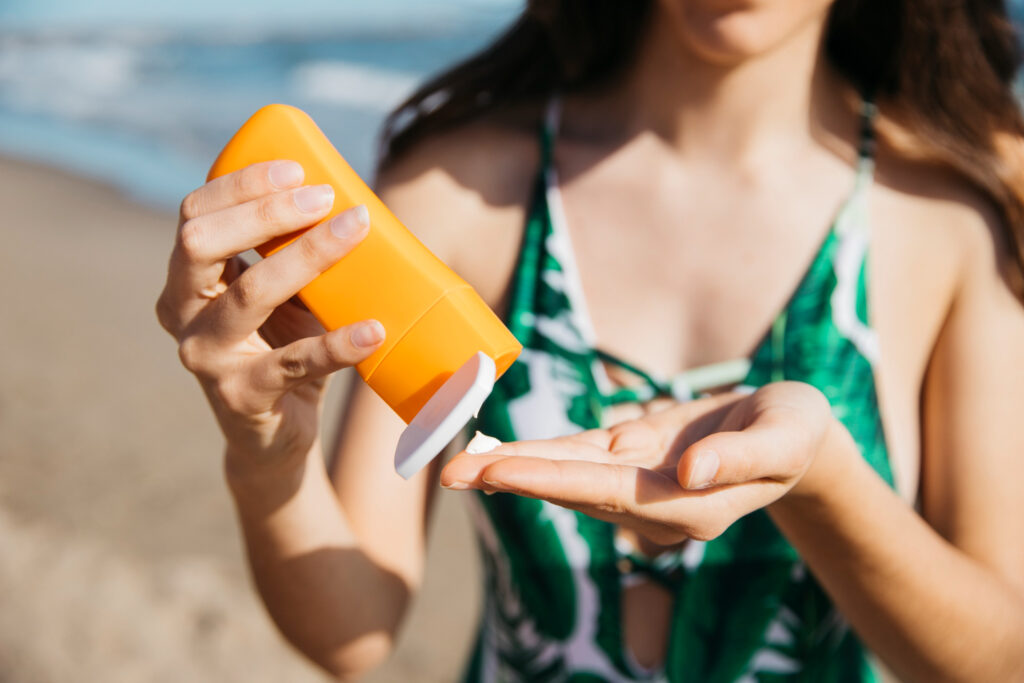
Fast Facts
Sunscreen Protects Against UV Damage: Sunscreen absorbs UVB radiation, preventing skin cell DNA damage that can lead to skin cancer
Vitamin D from Sunlight: Light-skinned individuals need about 10-15 minutes of sun exposure on the face, arms, and legs a few times a week for adequate vitamin D, while those with darker skin may need up to 30 more minutes.
Sun Safety Guidelines: The American Academy of Dermatology (AAD) recommends daily sunscreen use on exposed skin, but brief unprotected exposure can benefit vitamin D levels and mood according to some dermatologists.
By now, you’re likely aware of the importance of applying sunscreen when spending a day poolside or at the beach. But what about brief exposures to sunlight? The rules can seem a bit unclear.
The American Academy of Dermatology (AAD) advises people to “apply sunscreen every day on skin not covered by clothing if you will be outside,” but not everyone agrees with this strict approach.9
Some individuals, like reality star Kristin Cavallari, argue against the need for sunscreen entirely. Others, like reporter Rowan Jacobsen, suggest that not everyone needs to use sunscreen as often as U.S. guidelines suggest. In his May 10 article in The Atlantic titled “Against Sunscreen Absolutism,” Jacobsen discusses Australia’s updated sun safety guidelines, which allow for some sunscreen-free time to benefit from natural vitamin D exposure.
With conflicting advice, you might wonder if it’s always necessary to apply sunscreen when you go outside, or if it’s ever okay—or even beneficial—to enjoy some sun exposure without protection. Here’s what dermatologists have to say.
The Connection Between Sunscreen, Skin Protection, and Vitamin D
To understand whether it’s healthy to skip sunscreen, it’s crucial to know how sunscreen affects your health. Sunscreen forms a barrier that absorbs ultraviolet B (UVB) radiation from the sun before it can penetrate the skin. This radiation can damage skin cell DNA, potentially leading to cancerous mutations.
However, sunscreen also blocks UVB rays, which can limit the body’s ability to produce vitamin D, essential for immune and bone health. While you can get some vitamin D from your diet and supplements, the primary natural source is sunlight.
Light-skinned people generally need about 10 to 15 minutes of sun exposure on the face, arms, and legs a few times a week to get sufficient vitamin D, according to Jonathan Ungar, MD, an assistant professor of dermatology and medical director of the Waldman Melanoma and Skin Cancer Center at Mount Sinai. People with darker skin may require up to 30 more minutes due to higher melanin levels, which protect against UV radiation

Ungar notes that these estimates are simplistic and can vary based on several factors, including the strength of UV rays, which are highest in spring and summer, closer to the equator, and between 10 a.m. and 4 p.m.
Is It Always Necessary to Wear Sunscreen Outdoors?
Australia’s new guidelines suggest that for some people with darker skin tones, skipping a little sun protection may be beneficial for vitamin D exposure.
However, the AAD maintains that due to the risk of skin cancer, they do not recommend getting vitamin D from sun exposure. A spokesperson told The Atlantic that UV rays can cause skin cancer, so the Academy advises against relying on the sun for vitamin D.
Diya Mutasim, MD, a professor in the department of dermatology at the University of Cincinnati College of Medicine, acknowledges some benefits of brief sun exposure for vitamin D synthesis and mood. He suggests that very short bursts of sunshine, like a quick walk to your car, might not necessitate sunscreen.
However, for prolonged periods outdoors, Mutasim stresses finding a balance between risks and benefits. “As I tell my patients, there are two main ways to get Vitamin D, sun exposure vs supplementation. Only one of these is known to increase the risk of skin cancer, but you have to choose for yourself.”
The goal is to gain the sun’s benefits without damaging your skin. Mild redness and tans indicate sun damage, which should be avoided.
Factors like cloud cover, time of day, and season can influence the risk of sun damage. People with darker skin have a lower chance of sun damage but are not immune to skin cancer.
“A very fair-skinned individual may not tolerate more than five minutes without protection, while a darker-skinned person may tolerate 40 minutes,” Mutasim said.
summary
Anyone planning to be in the sun for an extended period should protect exposed skin. The AAD recommends using a water-resistant sunscreen with broad-spectrum protection and an SPF of at least 30. Ensuring skin protection while enjoying the sun responsibly is key to balancing health benefits and risks











